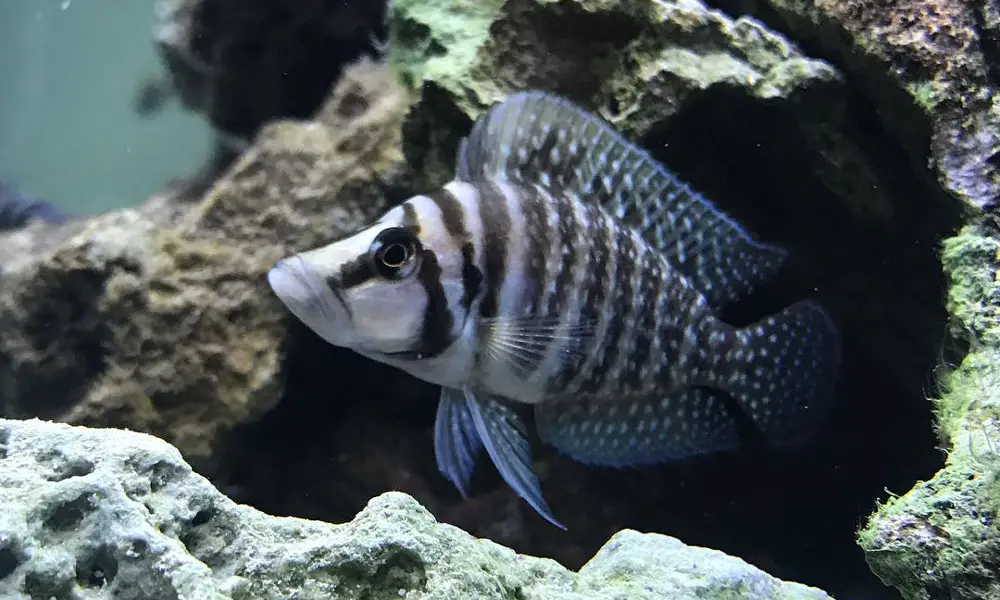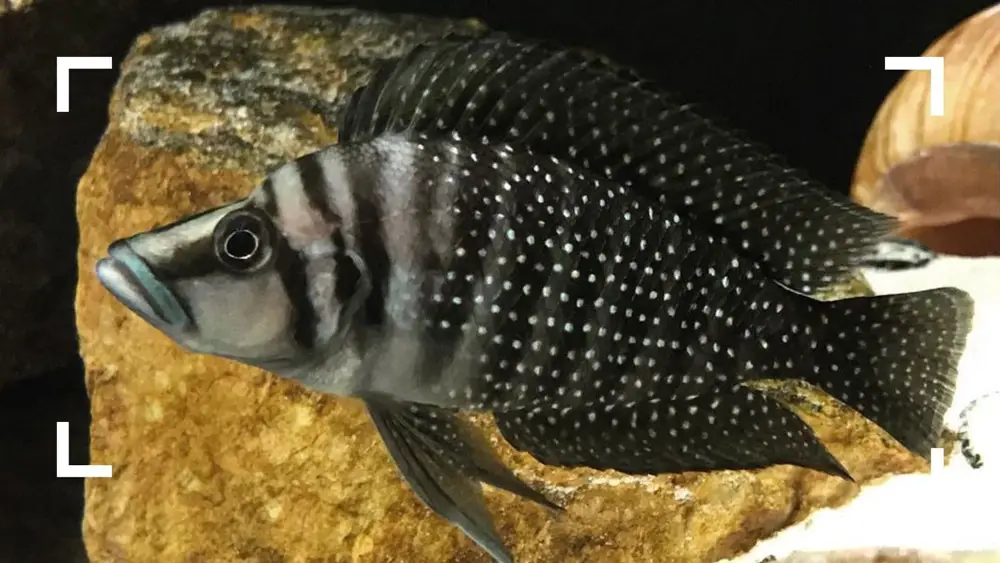The Calvus Cichlid (altolamprologus calvus) is a beautiful Lake Tanganyika fish that is known for its striking coloration and unique shape. With so many other fascinating species out there, it’s no wonder that the Calvus Cichlid is often overlooked. But this fish is definitely worth getting to know.
Like most Africa Cichlid, this medium-sized fish can be aggressive, and they’re not afraid to show it. Therefore, they require a bit of extra care and attention, making them best suited for experienced aquarists.
Fortunately, they are relatively easy to care for as long as you know what they need. In this article, we’ll discuss everything you need to know about Calvus Cichlid care so you can decide if this is the right fish for you.
Species Summary
Calvus cichlids (altolamprologus calvus) originate from the southern shoreline of Lake Tanganyika, located in Eastern Africa. However, several geographical variants of this species exist, and each of them has a unique color based on its location. Most of them generally live in rocky environments at a 3 – 40m.
This fish belongs to the Cichlidae family and the Altolamprologus genus, and it has derived its name Calvus (means “bald” in Latin) because of the scaleless area on its forehead. There are a number of known common names for this species, including Calvus Cichlid, Pearly Calvus, Pearly Compressiceps, white pearly calvus, and pearly lamprologus.
The genus Altolamprologus has two formally described species: A. calvus and A. compressiceps. Both species don’t grow any larger than 6 inches (15 cm) in length, but they are natural predators that feed on smaller fish and large invertebrates in small crevices between rocks, particularly crustaceans and other juvenile cichlids of various species.
These two species share similar habitats and behavior, but A. calvus is shallow-bodied and has a longer snout. Additionally, the A. calvus is currently listed on the IUCN Red List, while the A. compressiceps is not considered threatened.
| Scientific Name: | Altolamprologus calvus |
| Common Name: | Calvus Cichlid, Pearly Calvus, Pearly Compressiceps, white pearly calvus, and pearly lamprologus |
| Origin: | Lake Tanganyika |
| Aggressiveness: | Relatively Peaceful |
| Size: | Males: 6 inches (15 cm); Females: 4 inches (10 cm) |
| Lifespan: | 8 to 10 years |
| pH: | 7.5 – 9.0 |
| Temperature: | 76° – 81° F (24° – 27° C) |
| KH: | 8 – 20 dKH |
| Minimum tank size: | 55 gallons |
| Diet: | Carnivorous |
Appearance

Calvus Cichlid is quite distinctive in color and shape. This species has a longer, shallower body, giving them a more streamlined look. They are laterally compressed and feature a high back and a steep forehead.
Their scales are quite sharp and can destroy the lips of the biting enemy. Calvus cichlids boast dark vertical stripes in their front portions, and the back part is speckled with fading stripes.
Like many other types of African cichlids, several geographic variants are available, each with its own interesting coloration. Depending on the variety, the coloration can range from white to black, and the stripes can be light blue or dark brown. Many notable variants include:
- Altolamprologus calvus ‘Black Sambia’
- Altolamprologus calvus ‘Black Pectoral’
- Altolamprologus calvus ‘Black Zaire’
- Altolamprologus calvus ‘Black Kapampa’
- Altolamprologus calvus ‘Yellow’
- Altolamprologus calvus ‘White’
Calvus Cichlid (Altolamprologus Calvus) Size
The average size of Calvus Cichlid is 5.3 inches (13.4 cm); Males grow larger, up to 6 inches (15 cm), while females only reach about 4 inches (10 cm).
When sold in stores, the juveniles are usually only one inch long or even smaller. Altolamprologus Calvus are slow-growth species that will take 3-5 years to reach full size.
Here are some records of Calvus Cichlid growth rate from the fish keeping community:
“My males were around 3″ . My females at 5 years+ are still under 3″. Males are around 5″ now.”
“They are VERY slow growers. I have one that’s about 6 months old, and he’s barely 1.25”.
“i have a year with them and they are at 2”
Lifespan
Fortunately, they are long-lived fish. Calvus Cichlids can live about 8 to 10 years with proper care.
There have been recorded that Calvus has lived as long as 10 – 13 years. While these are obviously outliers, it goes to show that these fish can have a decent lifespan in captivity with the right care.
Provide them with good food and stick to the appropriate tank conditions to increase their life expectancy.
Calvus Cichlid (Altolamprologus Calvus) Care

Calvus Cichlid care should be manageable for anyone who has some experience with caring for African cichlids. They are not as aggressive as some other species, but they will still need a tank that can provide them with plenty of hiding places and room to swim.
These fish inhabit the rocky area around the shores and islands of the lake. They are active swimmers that spend most of their time in the bottom and middle areas of the aquarium, but they do need a lot of hiding places in the form of caves and rocks.
You can keep them in pairs or groups. This Cichlid is relatively peaceful toward their own kind and can tolerate other peaceful rift lake cichlids.
Tank Size
An aquarium size of 55 gallons or more is recommended to keep a group of 4 – 6 adult Calvus cichlids. These species are not ideal for small tanks as they are active cichlids that require ample space for swimming and hideouts.
However, you can keep the juveniles in a 20-gallon tank until they mature. These are slow-growing cichlids, so you don’t have to shift them into a big tank anytime soon.
Water Parameters
Altolamprologus Calvus can survive in either freshwater or slightly brackish water conditions; however, they prefer a neutral to slightly alkaline pH.
Interestingly, all Tanganyika species need iodine for the thyroid to function properly, which regulates their metabolism. Depending on the water quality in your area, you may need to supplement their water with iodine. A good way to provide iodine is through aquarium salt (not table salt). If it’s needed, then make sure to follow the directions on the package.
Lake Tanganyika’s natural habitat is rich in oxygen. You should aim to provide similar conditions in the aquarium.
Keep a check on nitrates and pH and perform regular water changes and make sure the filter is strong enough to provide adequate circulation. A good rule of thumb is to change at least 20% of the water once a week.
Follow the water parameters mentioned below and let these species thrive comfortably.
- pH: 7.5 – 9.0
- Water Temperature: 76° – 81° F (24° – 27° C)
- Hardness: 8 – 20 dKH
- Ammonia: 0 ppm
- Nitrite: 0 ppm
- Nitrate: <30 ppm
Decor (Plants and Substrate)
In their natural habits, Calvus cichlids live in rocky areas with plenty of hiding places. You need to provide them with the same in their aquarium setup as well.
Use a lot of rocks and cave-like structures to create hiding places for these cichlids. Make sure there are plenty of open swimming areas.
The substrate can be sand or a small gravel substrate. A dark substrate is better than a light one because it will help bring out the colors of these cichlids. Black diamond blasting sand is a good option. Your black Calvus will become very dark, and its white spots will be more visible and sparkle.
Since these fish come from the deep water of the lake, dim lighting will make them feel more comfortable.
Live plants are unnecessary, but you can include them if you want. Only choose the low lighting plants that can be securely anchored to rocks. Java fern, Anubias, and amazon swords are some good options.
Food
Feeding these cichlids isn’t a hassle; however, you should have a good knowledge of their food to offer them a well-balanced and appropriate diet. They are carnivores that generally feed on insect larvae, smaller fish, and crustaceans in the wild.
You can offer them live foods, like earthworms and Mysis shrimp in captivity to satiate their cravings. In addition, commercial dried food is acceptable, but they prefer frozen meaty fare, and dried flakes or pellets will not bring a female Calvus into breeding condition.
Calvus Cichlid (altolamprologus calvus) Tank Mates
The Calvus Cichlid is a territorial but relatively peaceful fish that is best kept in pairs or groups in a species-specific tank. If you intend to breed Calvus, then avoid other color variations to prevent hybridization.
You can also keep them in a community tank with other peaceful Lake Tanganyika cichlids of similar size and temperament. However, you need to make sure that your tank is large enough as they will establish a territory and can become aggressive towards conspecifics.
Be aware the Calvus is a carnivore and slow-growing predatory fish that has specific dietary needs. It’s best not to keep them with small fish or inverts as they may view them as potential prey.
They can tolerate other peaceful cichlids but do not keep them with Mbuna or species from the Tropheus or Petrochromis genera.
Some possible tank mates for Calvus cichlids are:
- Neolamprologus caudopunctatus
- Cyprichromis leptosoma (Sardine Cichlid)
- Julidochromis marksmithi
- Synodontis catfish (Lace catfish)
Breeding Calvus Cichlids
Both A. calvus and A. compressiceps are substrate spawners bred in the home aquarium for years. Sometimes you will miss out on the actual spawning event as it happens very secretively.
The most important thing you can do is obtain a mated pair. We highly recommended to start with a group of 4 to 6 juveniles and letting them pair up naturally in a 20 gallons tank. Unfortunately, it generally takes 2 years for them to form a pair and reach sexual maturity.
To initiate spawning, house the pair in a 20-gallon breeding tank with the same conditions as their main tank. These cichlids are not picky about their spawning sites but prefer a cave or rockwork with plenty of hiding places. At the same time, feed them live and frozen foods to bring the female into breeding condition.
You will know spawning is about to occur when the female Calvus starts to choose a certain cave or large shell that only she can fit. The female will then lay her eggs (up to 200 eggs, depending on the size and age) on the substrate inside the cave or shell, while the male releases his sperm at the entrance.
The pair then use their pectoral fins to fan the water to lead the milt towards the eggs for fertilization. After fertilization, the female will carefully tend to the eggs whilst the male guards the entrance of the cave.
The Calvus cichlid eggs hatch after 3 to 4 days and are free-swimming after 8 to 10 days. Once the eggs have hatched, the male should be removed from the tank as he will eat the fry, or you can move the fry to a 5-gallon tank with a sponge filter.
The fry can be fed with a diet of brine shrimp nauplii and microworms. As they grow, you can start to wean them live foods.
Final Thoughts
That’s all about the Calvus Cichlid care guide. While these species are an absolute delight to own, caring for them is slightly challenging. Also, these are not considered ideal for beginners, so they should gain some more experience before adding these beautiful cichlids to their tanks.
Choose their ideal companions and offer them a well-balanced and nutritious diet and let them thrive in a healthy environment. Keeping them will become easier once you learn about their behavioral tendencies. So, wait no more and make these slow-growing, active cichlids a part of your aqua space.
As always, if you have any questions or comments about Calvus cichlids, feel free to reach out to us!





